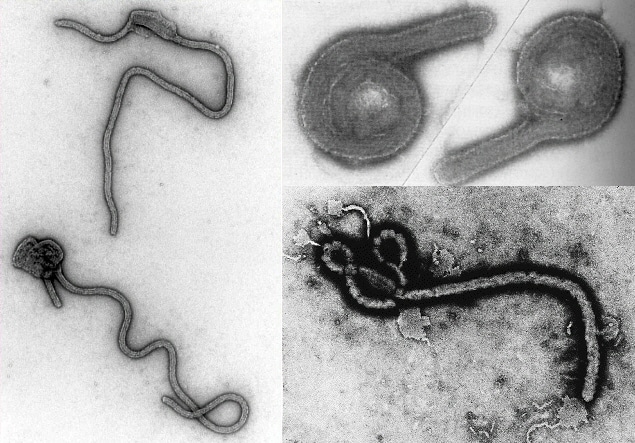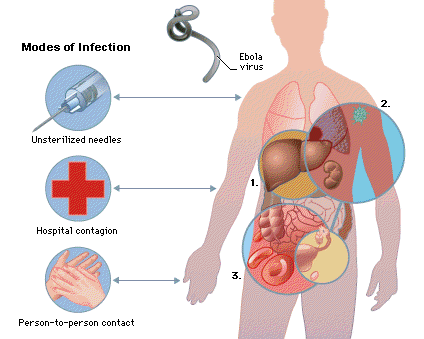Ebola was first discovered in the village of Yambuku(1) near the Ebola River in Zaire. Since its discovery, there have been four  outbreaks of this disease. There are three known strains, of variations of Ebola. There is no known cure for this disease (2).Ebola has become one of the most mysterious and feared viruses on the face of this earth. Ebola’s first documented appearance was in Zaire in 1976. No one knows where Ebola comes from or what the original host is. However, scientists know that man is not Ebola’s natural host(3).The host was first suspected of being carried by monkeys in the African rain forests(4), but in one case the monkeys at a holding facility broke out and had to be killed. In the pursuit of a cure and an origin, there have been several teams of scientists whose top priority is to find the viruses origin (5). The teams have trekked through the rainforests of Africa to collecting different species of animals, bugs, and plant life. Bugs are also collected from the hospital sand from the surrounding huts of the villages. So far 36,000specimens have been collected. Once they have been gathered, the specimens are put into liquid nitrogen and flown back to the United States, where they are studied at the Centers for Disease Control in Atlanta Georgia and the Army Medical Research Institute of Infectious Diseases at Fort Detrick Md.,(6). Researchers have discovered the source of human infection for all level four organisms except Ebola(7). This means that all organisms’ that cause deadly viruses have been contained and studied, and have had antibodies created to ward of the illnesses that are caused.
outbreaks of this disease. There are three known strains, of variations of Ebola. There is no known cure for this disease (2).Ebola has become one of the most mysterious and feared viruses on the face of this earth. Ebola’s first documented appearance was in Zaire in 1976. No one knows where Ebola comes from or what the original host is. However, scientists know that man is not Ebola’s natural host(3).The host was first suspected of being carried by monkeys in the African rain forests(4), but in one case the monkeys at a holding facility broke out and had to be killed. In the pursuit of a cure and an origin, there have been several teams of scientists whose top priority is to find the viruses origin (5). The teams have trekked through the rainforests of Africa to collecting different species of animals, bugs, and plant life. Bugs are also collected from the hospital sand from the surrounding huts of the villages. So far 36,000specimens have been collected. Once they have been gathered, the specimens are put into liquid nitrogen and flown back to the United States, where they are studied at the Centers for Disease Control in Atlanta Georgia and the Army Medical Research Institute of Infectious Diseases at Fort Detrick Md.,(6). Researchers have discovered the source of human infection for all level four organisms except Ebola(7). This means that all organisms’ that cause deadly viruses have been contained and studied, and have had antibodies created to ward of the illnesses that are caused.
Although Ebola is a mystery to humans, the virus is relatively hard to catch and it kills quickly, lessening the chance victims will infect others. It is transmitted by contact with bodily fluids like blood, vomit and sperm or contaminated syringes and is not known to be passed along through casual contact(8). When the first outbreak of Ebola occurred, it was in 1976 in Zaire and in Sudan at the same time. There were 318 cases reported in Zaire and 240 of those cases proved to be fatal. In Sudan, there were 284 cases and 134 of those cases proved to be fatal. In 1979, there was another small epidemic in the same region of Sudan. In 1989 there was a breakout in Reston Virginia, at a monkey holding facility, that killed over 400 monkeys that had been shipped from the Phillines. This strand however, is only lethal to monkeys and id not a threat to humans(9). In 1995, there was an outbreak in Kikwit Zaire that claimed 233 lives. At least7 people survived that outbreak because of a new break through that is a possible solution to the loss of lives that are suffered in a outbreak. Blood from one surviving patient can be transfused to a person of the same blood type to possibly save the person’s life. Such was the case in 1995(10).
Scientists were able to find who the first person to contract the virus was in 1995. The man’s name was Gaspard Menga. Menga infected his family, and his family infected others (11). Menga is known as the index patient. The reason it is so important to have the index patient is that this way they can trace the patient’s movements and try to find the origin of the virus. Scientists are now arguing that if there wasn’t so much interference with the rain forests that there wouldn’t be new diseases emerging all the time(12) The most recent outbreak happened in January of 1996 in a small village in inland Zaire. Two children were playing when they came upon a dead chimpanzee and they took it back to the village where the villagers celebrated for the finding of such a wonderful thing. The  reason this was so celebrated was because meat is rare in that village. Anyone who helped cleans or cooks the animal became ill with the deadly Ebola virus. The final death count was16 people. Villagers have been warned not to eat any animals that they find already dead and to be careful not to eat any sick animals that they may encounter. Scientists now believe that monkeys are not the original host because they seem to just as susceptible to the disease as humans. Scientists are hoping that they will make some substantial discoveries with this outbreak.(13) Scientists do know that Ebola is a strand of seven proteins(14) that belongs to a family of viruses called filovirusus. The virus consists of a shell of proteins surrounding genetic material. The virus attaches itself to a host cell, and changes the chemicals makeup to fit its own so that it can reproduce(15).
reason this was so celebrated was because meat is rare in that village. Anyone who helped cleans or cooks the animal became ill with the deadly Ebola virus. The final death count was16 people. Villagers have been warned not to eat any animals that they find already dead and to be careful not to eat any sick animals that they may encounter. Scientists now believe that monkeys are not the original host because they seem to just as susceptible to the disease as humans. Scientists are hoping that they will make some substantial discoveries with this outbreak.(13) Scientists do know that Ebola is a strand of seven proteins(14) that belongs to a family of viruses called filovirusus. The virus consists of a shell of proteins surrounding genetic material. The virus attaches itself to a host cell, and changes the chemicals makeup to fit its own so that it can reproduce(15).
Ebola is a hemorrhagic virus that has a short incubation period of about two days to two weeks(16). It causes high fever, chills, internal and external bleeding, vomiting, the eyes turn red and the skin becomes blotchy and bruises appear. The surface eveins and arteries erode. Organs liquefy and blood flows from every opening in the body including the eyes and ears(17). This is followed by a painful death that usually occurs within three weeks(18). There are three known strains of The virus. Ebola Zaire, Ebola Sudan, and Ebola Reston. Ebola Zaire is the most lethal of the three followed by Ebola Sudan and then Ebola Reston. Ebola Reston is the least worried about because it has not proved to be hostile to humans. The question of whether or not this virus could become airborne has struck fear in many. Scientists say that it is unlikely that it will become airborne, because it is killed by ultraviolet rays within seconds. The only way that it could survive is if it mutated to become resistant to ultraviolet rays. At this point, a person is more likely to contract HIV than it is to contract the Ebola virus, although it takes ten years to affect a person the way Ebola does in ten days. Even though Ebola is a very mysterious and feared disease, it is in the process of becoming more understood. It can destroy an entire city in a matter of weeks, and could wipe out an entire nation if it ever became airborne, but it is a very difficult disease to contract so the United States is probably safe from any near future epidemics.
On the other hand many third world countries could have serious problems if there is an outbreak due to unsanitary living and medical conditions. The hospitals and medical personnel reuse needles that have been infected and they don’t use latex or any other kind of gloves which can be a cause of widespread sickness. Everyone hopes that diseases like Ebola will not get out of control before a cure can be found. Such hopes seem unreasonable due to the facilities available in some areas of the world.
